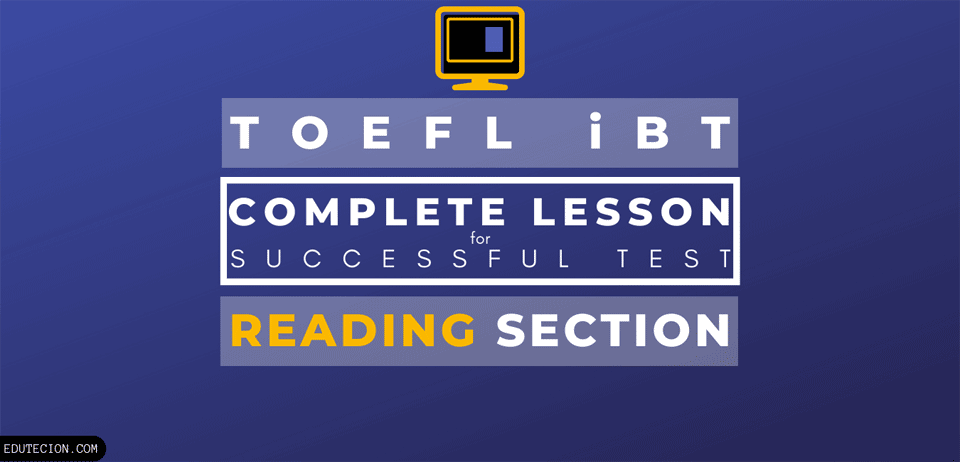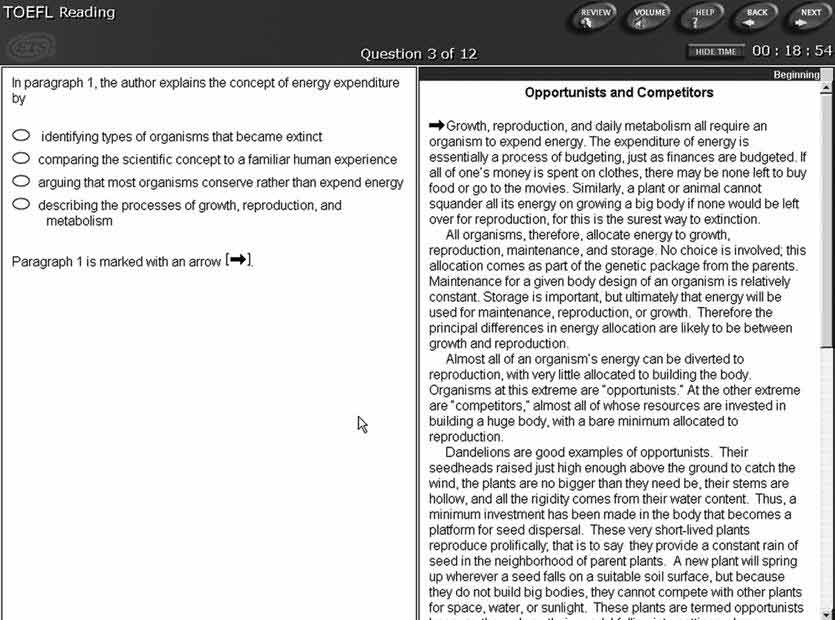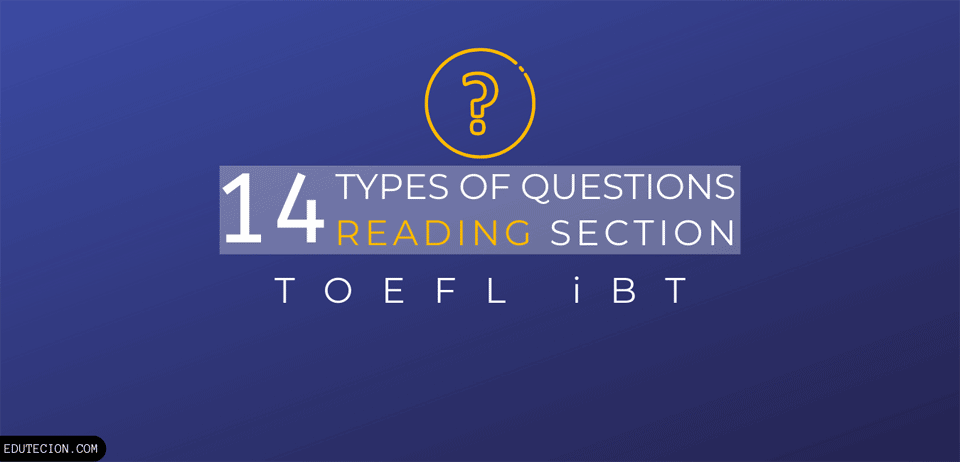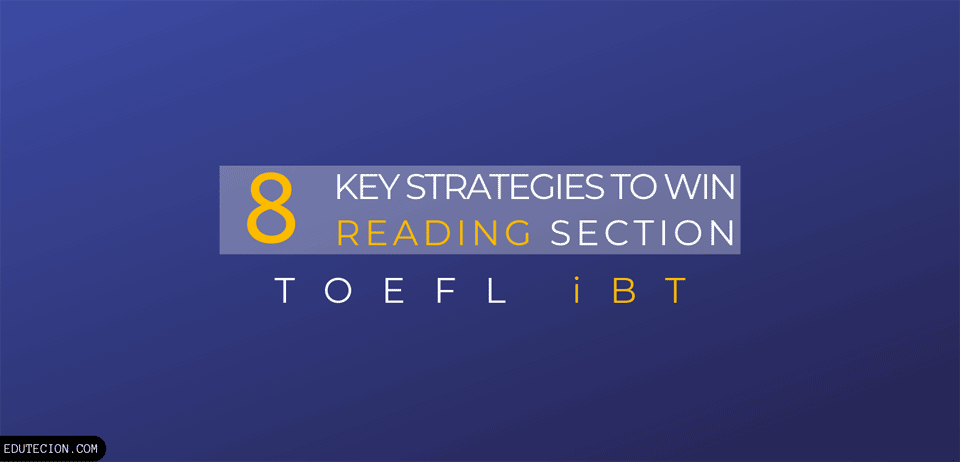8 Most Effective Strategies for Reading Section of TOEFL iBT (UPDATED 2024)
Are you struggle to find the most effective strategies for reading section of toefl ibt? Here, you can learn about them to score well for free.

Most Effective Strategies for Reading Section of TOEFL iBT – In TOEFL iBT, reading is one of four sections that you need to win to get the best score. See, reading is the first section you’ll encounter in the TOEFL iBT test. You can’t jump to the next section without completing this first section.
As you’re taking the TOEFL iBT test, you’ll complete this section (like other sections) on a computer screen.
So, what did you do to make the best of it?
Be extra frequent with reading paragraphs on the computer screen. It super helps me a lot!
Sigh, the first time I did this, it took me longer to understand the meaning of articles that I read on my laptop screen than on a page of a physical book. Have you experienced the similarly as me?
But, as I practice and practice reading articles more on the screen – laptop and smartphone, I have no problem anymore with that.
You should try it too!
Look, what I mean by practicing here is reading articles that academically written by experts or researchers. Not by reading chats, tweets, or YouTube comments. It’s equally fun.
If you want to know more about the TOEFL iBT reading section and effective strategies for winning it. You can keep scrolling.
Are you ready? Let’s go…
Table of Contents 📚
Formats of Reading Section
The reading section has two formats; short and long format. The difference about them is how many passages each format incorporated.
The short format includes three passages and the long format includes four passages. So, how many in total?
Yes, you’re right!
There are 7 passages in total and you have to read and understand them to notice the right answer for each question.
Moreover, 12 – 14 questions expecting you after each passage that you’ll require to answer. So, there are around 36 – 42 questions in total.
Now you know what you’ll receive as you start the Reading section.
Then how to correctly answer those questions? Check the next part bellow to know it!
How to Answer TOEFL iBT Reading Section
You need to pick one right answer to each multiple-choice question by clicking the oval shape or other shapes on the left of each option.
Keep in mind:
You need to follow each question and instruction to avoid misinterpretation which leads to the wrong answer.
Additionally, each type of question has different instructions and choices. So pay complete attention to each question, you’ll see each of them is distinctive.
On the screen, you’ll see something like this.

You can click on the “REVIEW” button to see a report showing the questions you’ve answered and the ones you’ve not yet answered.
Did you know?
You can choose the question you required to answer or to revise anytime from there.
You can click the “NEXT” button to hop to the next question or click the “PREVIOUS” button to move back to the previous question. Keep in mind, you can identify your position by seeing the indicator on the top center screen like “Question 6 of 12”.
Here is the best practice:
Answer all the questions without leaving any blank (click “REVIEW” button to detect them).
You don’t need to worry:
Your scores won’t be deducted when you choose the wrong answer.
Did you know?
Most of each question rewards 1 point. However, the last question of each passage rewards more than 1 point.
Therefore, don’t get distracted:
It’s propitious to do your best for all of them.
Okay, I’ll tell you about how long the Reading section takes, so you can find out how to overcome them.
Ready? Let’s go…
How Long TOEFL iBT Reading Section Takes
Each passage is about 650 to 800 words long. You can multiply that with the number of passages (seven) you’ll read.
Keep in mind:
You have 60 – 80 minutes to finish all of them.
Is it enough? Yes, definitely. As long as you know how the strategies to make it work.
Well, that’s the purpose of TOEFL iBT, it measures your reading ability out of ordinary circumstances. Keep in mind, all the passages have not different from the ones you’ve encountered in the undergraduate college textbook.
Commonly, the passages are about natural sciences, social sciences, humanities, or arts. Additionally, each passage provides glossaries for the unfamiliar technical terms to help the test-takers to perceive more information about the passage.
Be worry-free, you’ll get what you need to overcome this Reading section, in fact, all sections here. I’ll assist you through my writing.
As you comprehended the formats, how to answer, and how long the Reading section of TOEFL iBT, you’ll know about common questions that implemented to test your reading ability.
Ready? Let’s roll then…
Common Types of Questions in TOEFL iBT Reading Section

Look, I need you to be more familiar with the types of questions that normally tested on TOEFL iBT, so you can have common knowledge about what to study and anticipate for the test.
It’s like you can steal a start in a legit way!
That’s why I’m going to provide you with the list of them arranged based on their appearing frequency on every test. Check them out!
- Vocabulary (Very High)
You understand easier about reading if you have enough vocabulary. Do you agree with that?
That’s why vocabulary questions are the most frequent or most obvious to spot in the reading section.
Generally, you need to know the synonyms of words or phrases mentioned in every passage.
So you should build vocabulary to make this test easier for you.
- Detail (Very High)
Again, as the reader, you should understand the detail information of what you’ve read. By understanding the detail, you can get the essence of every reading you do.
That’s why detail questions also frequently appear in the TOEFL iBT reading section.
Keep in mind:
Detail question asks you to indicate specific information from the passage. Thus pay attention to detail is required to get the right answer.
Note that:
You shouldn’t have to read the whole passage to win this type of question. Every detail question has clear directions on where to start or to get the detail information from the passage. See, be worry-free!
- Inference (Very High)
It’s necessary as the readers to formulate a conclusion about what they’ve read. Meaning, when you can conclude correctly what you’ve read, you have a precise understanding of it. Don’t you think so?
Keep in mind:
Inference questions instruct you to draw a conclusion precisely based on information from the passage.
You should choose one best sentence which concludes what question asked from the options provided.
- Insert (High)
Well, this is like filling the blank quizzes that you usually encounter in the learning process.
Insert questions charge you to accurately embed a suitable sentence to the most suitable spot in a passage (there are four spots, you choose one that’s accurate).
Frankly, your job is to match given sentences with the right spot in the passage.
- Reference (High)
This type of question is almost similar to a detail question. The slight difference is located on its form. Detail refers to sentence and reference refers to word or phrase.
What you need to do:
You need to classify a word or phrase in the passage that relates to another word or phrase in the available options.
In other words, choose the one best word or phrase from four options that correctly relate to the highlighted word or phrase in the passage.
- Paraphrase (High)
Yeah, you’re right. It’s about the restatement. But what should you restate exactly? Well, the answer to that is the sentences.
You know, in every paraphrase question, you should choose the best restatement of given or highlighted sentences from the passage (choose the best sentence between four options that accurately restate highlighted sentences).
- Summary (High)
Yes, it’s just like what you think it is. Summary questions expect you to make a complete summary of the passage.
Unlike other types of questions,
For this one, you need to choose not only one but three correct sentences from six available options.
- True-False (Average)
True-false questions are asked you to distinguish the true statement.
You’re required to choose the correct statement of four options toward the given term in the question.
See, you can get the answer by correlating the given term with the information of the passage.
- Terms (Average)
Terms questions provide you a specific term and detailed location of where to spot it in the passage.
Look, your job is to choose the right explanation from four available options that you can link to the information in the passage.
- Purpose (Average)
Yeah, just like its name, purpose questions challenge you to identify the purpose of the passage such as the author’s intention, or the background of the passage written as a whole.
You need to master a particular strategy to be able to find the correct answer to this type of question.
- Cause (Average)
The cause questions test you to describe why something occurred in the passage. Look, it’s crucial to understand the whole passage to get the right answer. And I know you can do that.
All you need is to pick the right answer by grasping information in the passage, in the specific area, where the question pointed it.
- Opinion (Average)
See, opinion questions ask you to acknowledge the author’s point of view. Well, as you read the passage, you’ll get the author’s opinion toward a particular topic he/she wrote.
- Exception (Average)
Yeah, I know that you’re familiar with this type of question already.
Exception questions ask you to choose one that is not related to any information from the passage.
But, you need to apprehend the whole meaning of the passage to correctly answer the question.
- Classification (Low)
All right, this is the last type of question regularly tested on the TOEFL iBT reading section. Did you know? Classification questions are most unusual than others.
See, you are required to match phrases with the divisions to which they refer. Your job is to pay attention to the question’s instruction because it can be different.
For instance:
You need to choose phrases for two given divisions or you choose the phrases that not match the division according to the passage.
Well, there are fourteen common types of questions in the reading section of TOEFL iBT. And you just recognized them all briefly.
But, if you want to know the key strategies to get the right answer in the reading section of TOEFL iBT. Well, you can proceed to read them bellow.
Are you ready? Let’s do this…
Most Effective Strategies for Reading Section of TOEFL iBT

As you know, TOEFL iBT measures your English proficiency by evaluating four language skills – reading, writing, listening, and speaking. Also, it makes you familiar with academic contexts.
So preparing well for the TOEFL iBT test helps you to not only succeed in the test but also succeed in your academic or working setting.
For this article, I focus on the reading section. That’s why I provide key strategies to win the reading section in TOEFL iBT. So you can learn, practice, and apply them to get your best TOEFL score.
Are you ready? Let’s get started!
- Question First, Passage Second
Well, when you’re in the reading section, you see long passages staring back at you. The clock is ticking and the time is running out. Ugh, intimidating.
Look, don’t get distracted by those long passages. And remember:
Question first, passage second.
Read the question carefully and understand its request. Then you can start to read the passage based on that question’s instruction.
Keep in mind, don’t read the whole passage first then go to the questions after that. It’s wasting time.
By doing this strategy, you do what necessary and be efficient. So It helps a lot in decreasing the use of time for completing each passage. You should try it!
After you know what to do in the first place, you can use the next effective strategies to answer different types of questions in the reading section TOEFL iBT.
Ready? Let’s move on!
- Preview
Previewing is a process of finding the general idea of the topic in a passage. It helps you to know what a passage is about quickly and efficiently. So you can save precious time.
As you know, there are seven passages in total that you have to understand to be able to answer every question after them. And you only have 60 – 80 minutes to read and answer all questions.
You can get the general idea of the topic in a passage in seconds when you master this strategy.
Look, it’s so easy. All you need to do is look at the title and headings, read the first sentence of each paragraph, and read the last sentence of the passage.
Just like that, you get the general idea about any passage in the reading section TOEFL iBT. Keep practicing!
The next strategy I’m going to tell you is also beneficial, it helps you to understand the content of any passage. Curious? Yes, you should be.
- Use Peripheral Vision
Peripheral vision is the insight that enables you to understand on either side of the word you’re concentrating on with your eyes. So this insight helps you to read the content faster.
As you know, reading faster is also helpful to save your precious time. It helps you grasp the meaning of the passage in no time.
The way to do that is to read for meaning. It means that you need to understand the sentences or even paragraphs, not individual words.
However, when you find a word or phrase in a sentence that makes you can’t understand the meaning of that sentence, the next strategy helps you do overcome that problem.
- Use Contexts
Did you know? Having sufficient vocabulary of a foreign language is a lifesaver. It helps you to understand every word, phrase, sentence, paragraph, and a whole passage.
However, in some situation like in the reading section of the TOEFL iBT test, you find an unfamiliar word or phrase that limit your understanding of the passage.
Look, when you encounter that situation, use context to understand the whole meaning of a sentence even you don’t know all the words that form it.
What is the context? the answer is, it’s the mixture of vocabulary and grammar that encompasses a word. It also can be a sentence or a paragraph in a passage.
Its job is to help the reader as you to predict the meaning of a word, sentence, or even paragraph.
- Make Inferences
As you know, some passages state direct facts that you can use to conclude the meaning. But some don’t.
And most of the passages in the reading section TOEFL iBT don’t state the facts that make test-takers easily conclude.
So how to overcome the challenge? The answer is making inferences.
Making inferences is a process of collecting facts of passage and generating them into a conclusion.
Sometimes, it’s a bit challenging to find the facts that spread over the passage. So the next strategy can back you up to solve that kind of problem.
- Skim and Scan
You know what it is, right? It’s just like what your teacher always teaches you in reading class. Skimming and scanning to get what you’re looking for quickly.
Here additional information about it especially in TOEFL iBT:
As I mentioned, read the question first then go to passage second, by doing that you can get clear instructions and hint about where to get the answer from the passage.
If not, you use skimming and scanning to locate the word, phrase, or sentence from the question in the passage.
- Make Connection
This strategy is advantageous for a type of question that requires you to input a sentence at the most suitable spot in the passage. Look, being an active reader is the best approach for this challenge. How to be an active reader? The answer is making a connection with the passage.
See, you’re making a connection when you can refer back to the previous point in the passage after you read a word, phrase, or sentence from the question.
- Summarize
The summary is the essence of a passage. You can get the summary of any passage by rereading the title, get the main idea, and list the major points.
Commonly, many writers use the rubric with one main idea and three primary points to form a complete passage in English. And some in a custom way, some writers include two or four primary points.
See, that’s the clear hints. You can use them to form a perfect summary of any passage.
Conclusion
As you know, TOEFL iBT tests your English proficiency by measuring your reading, listening, speaking, and writing. Also, reading is the first section you meet during the test. You can’t jump to the next section without completing each section in order.
Moreover, this reading section has two distinctive formats: short and long. You need to answer questions after each passage with specific instructions. Also, you should manage your time wisely to finish all the questions in a limited given time.
Before taking the test, you should prepare well to get the best TOEFL iBT score of your dream. Every reading section test has its common types of questions that you should be familiar with.
As time is limited and questions are many, you need to be able to use no ordinary way of reading strategies. Practicing key strategies is the key to a successful result.
I know you can do it!
Congratulation! you have completed this lesson. I hope you find it helpful. If you have any questions regarding this lesson, feel free to mention it in the comment. Also, you can share the effective strategies that you used to win the reading section in TOELF iBT previously, so others can learn more. Cheers!